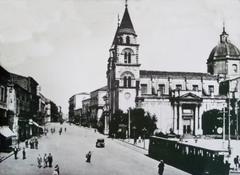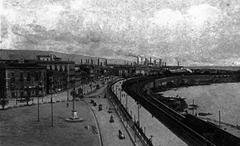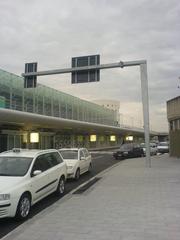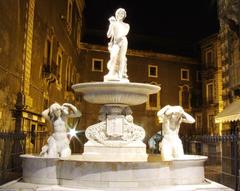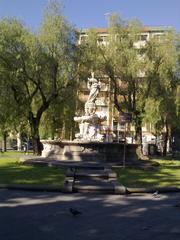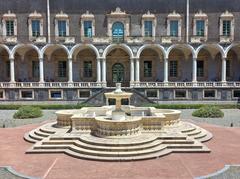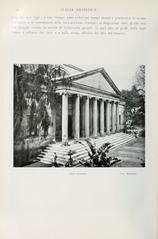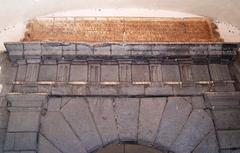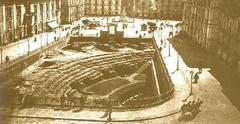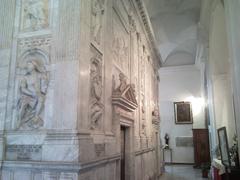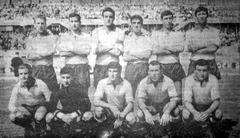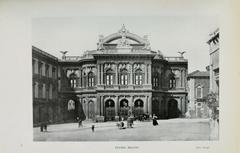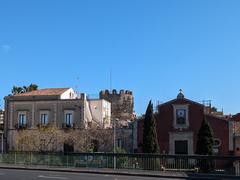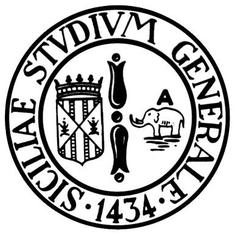Palazzo Boccadifuoco Visiting Hours, Tickets, and Guide to Catania Historical Sites
Date: 14/06/2025
Introduction
Palazzo Boccadifuoco stands as a striking symbol of Catania’s resilience and artistic legacy, embodying the grandeur of Sicilian Baroque that emerged in the aftermath of the 1693 earthquake and volcanic eruption. Located in the vibrant center of Catania near the Marina, this palace offers an immersive gateway to the city’s aristocratic past and its dynamic urban culture. Its distinctive façade of black lava stone from Mount Etna and white limestone, along with its ornate interiors, make it a living monument to the social, political, and artistic transformations that have defined Catania.
This guide provides all the essential information you need to plan your visit: from updated visiting hours and ticket options to accessibility, travel tips, and nearby attractions. You’ll also find insights into the palace’s historical significance, architectural highlights, and its ongoing role in Catania’s cultural life. Use official resources like the Catania cultural heritage website and curated local tours to enrich your experience at one of Sicily’s most iconic heritage sites. (Sicilia Secrets, Italia.it, UNESCO)
Quick Guide to Palazzo Boccadifuoco
Visiting Hours and Tickets
- Opening Hours: Tuesday–Sunday, 9:00 AM–6:00 PM (last entry 5:30 PM). Closed Mondays and select holidays. Seasonal variations may apply—check the official site for updates.
- Admission: Standard adult tickets range from €8–€10. Reduced rates for students, seniors, and children; children under 12 often enter free. Group and school visits can be arranged in advance.
- Booking: Purchase tickets online or at the entrance. Advance booking is recommended during peak seasons.
Accessibility
- Wheelchair Access: Main entrance and ground floor are accessible; some upper floors and private apartments have limited access due to historical constraints. Elevators and accessible restrooms available where possible. Contact staff in advance for personalized assistance.
Getting There
- Location: Via Boccadifuoco 12, Catania historic center, a short walk from Piazza del Duomo and the Marina.
- Public Transport: Bus lines 416 and 429 stop nearby. Catania Centrale railway station is approximately 1.5 km away.
- Parking: Limited paid parking lots available within a 10-minute walk. Early arrival is advised.
Nearby Attractions
- Piazza del Duomo: Iconic Elephant Fountain and Catania Cathedral.
- Palazzo Biscari: Another renowned Baroque palace.
- Teatro Massimo Bellini: Famous opera house.
- Benedictine Monastery: UNESCO World Heritage site.
- Vibrant Markets and Cafés: Experience local food and culture.
Historical and Cultural Context
The Baroque Renaissance in Catania
After the 1693 earthquake, Catania underwent an extensive Baroque transformation. Aristocratic families and religious institutions rebuilt the city using black lava stone from Mount Etna—creating the unique “black city” effect (Italia.it). Palazzo Boccadifuoco, constructed during this period, exemplifies the theatricality and innovation of Sicilian Baroque, with its undulating façade, elaborate balconies, and decorative stonework (Sicilia Secrets).
Aristocratic Patronage and Social Life
Noble families used palaces like Boccadifuoco to showcase wealth and status. These residences were centers for social gatherings, political discourse, and cultural events, featuring grand salons for concerts and salons (Scent of Sicily). The palace’s design and decoration were deliberate statements of power and taste.
Symbolism and Civic Identity
The palazzo’s location in the UNESCO-listed historic center underlines its importance in Catania’s collective memory and urban identity (UNESCO). Its enduring presence testifies to the city’s resilience and artistic renewal.
Architectural Highlights
Exterior and Façade
The façade combines black lava stone and white limestone, creating a dramatic chessboard effect characteristic of Catania’s Baroque buildings (alongdustyroads.com). Key features include:
- Grand arched entrance with family crest
- Ornate wrought iron balconies and elaborate corbels
- Volutes, floral motifs, and symmetrical design (e-a-a.com)
Interior Layout
- Courtyard: Central light-filled space, often with a Baroque double staircase, garden, or fountain (sicile-sicilia.net).
- Reception Rooms: High ceilings, interconnected salons, and richly decorated piano nobile for entertaining guests.
- Decorative Elements: Frescoed ceilings, stucco moldings, Murano glass chandeliers, marble floors, and period furniture.
Structural Innovations
Designed to withstand earthquakes, the palace features thick masonry walls, reinforced arches, and flexible wooden ceilings. Locally sourced materials ensure both resilience and elegance (alongdustyroads.com).
Conservation
Ongoing restoration efforts aim to preserve the palace’s authentic character while maintaining public accessibility (lovingsicilia.it).
Visitor Experience and Amenities
Tours and Languages
Guided tours—available in Italian, English, and other languages on request—offer deep dives into the palace’s history and architecture. Group sizes are limited for an intimate experience; advance booking highly recommended.
Facilities
- Restrooms: Available but limited.
- Cloakroom: Large bags and backpacks are not permitted; check for available storage facilities.
- Accessibility: Main public areas are generally accessible; inquire for specific needs.
Photography
Non-flash personal photography is allowed; tripods and professional gear require authorization. Respect signage and staff guidelines.
Dress Code and Etiquette
Wear comfortable shoes and respectful attire, particularly for private chapels or religious spaces. Avoid touching artworks and furnishings.
Special Events and Cultural Programs
The palace hosts concerts, art exhibitions, and educational workshops, especially during cultural festivals. During major local events like the Feast of Saint Agatha, special access tours may be available. Check event schedules on the official website.
Travel Tips
- Best Times to Visit: Weekday mornings and shoulder seasons (April–June, September–October) for pleasant weather and fewer crowds.
- Family Access: Children interested in history will enjoy the visit; strollers may be difficult due to stairs.
- Souvenirs: While there’s no palace gift shop, nearby boutiques offer Sicilian crafts and delicacies.
- Safety: The palace is secure, with staff and clear emergency procedures.
Frequently Asked Questions (FAQ)
Q: How do I buy tickets?
A: Purchase online through the official site or at the palace entrance. Advance booking is recommended.
Q: Are guided tours available in English?
A: Yes, with other languages available upon request.
Q: Is Palazzo Boccadifuoco wheelchair accessible?
A: Ground floor and main areas are accessible; upper floors have limited access. Contact in advance for special accommodations.
Q: Can I take photographs inside?
A: Non-flash photography for personal use is allowed; professional equipment requires permission.
Q: What are the best times to visit?
A: Weekday mornings and the shoulder seasons for fewer crowds and optimal weather.
Visual Gallery
- Exterior of Palazzo Boccadifuoco showing Baroque façade (alt: “Palazzo Boccadifuoco facade in Catania with Sicilian Baroque architecture”)
- Interior courtyard with ornate decorations (alt: “Courtyard of Palazzo Boccadifuoco with Baroque stonework”)
- Map showing the palace’s central location in Catania (alt: “Historic center map with Palazzo Boccadifuoco”)
High-quality images and virtual tours are available on the official palace website.
Preservation, Education, and Relevance
Palazzo Boccadifuoco is a cornerstone of Catania’s heritage, offering educational tours and cultural programming that connect visitors to the city’s artistic and historical legacy. The inclusion of Catania’s Baroque district as a UNESCO World Heritage site underscores the importance of ongoing restoration and sustainable tourism (Scent of Sicily, Great Sicily).
Plan Your Visit
For the most up-to-date information on visiting hours, tickets, and guided tours, consult the official Palazzo Boccadifuoco website and the Catania Tourism Board. Enhance your experience with the Audiala app for interactive tours, event updates, and insider tips.
Summary and Visitor Recommendations
Palazzo Boccadifuoco offers a journey through Catania’s rich Baroque heritage, combining architectural marvels with vibrant cultural experiences. To make the most of your visit:
- Check current hours and book tickets in advance.
- Consider guided tours for deeper insight.
- Explore nearby historical sites for a fuller experience.
- Respect preservation guidelines and enjoy local cuisine and crafts.
- Stay informed about special events and accessibility options.
Make Palazzo Boccadifuoco a highlight of your Sicilian adventure and immerse yourself in the storied heart of Catania. (official Palazzo Boccadifuoco website, Great Sicily, Scent of Sicily)
Sources and Further Reading
- Catania Cultural Heritage Website
- Sicilia Secrets: The UNESCO Sicilian Baroque Cities
- Italia.it: Catania Historical Guide
- UNESCO: Late Baroque Towns of the Val di Noto
- Scent of Sicily: Discover Sicilian Baroque
- Great Sicily: Catania City of History, Culture, and Mediterranean Flavors
- Along Dusty Roads: Things to Do in Catania
- E-A-A: 10 Best Architectural Buildings in Catania
- Sicile-Sicilia.net: Palazzi di Catania
- Lovingsicilia.it: Catania Palazzi Edifici
- In Love With Italy: Perfect Catania Itinerary
